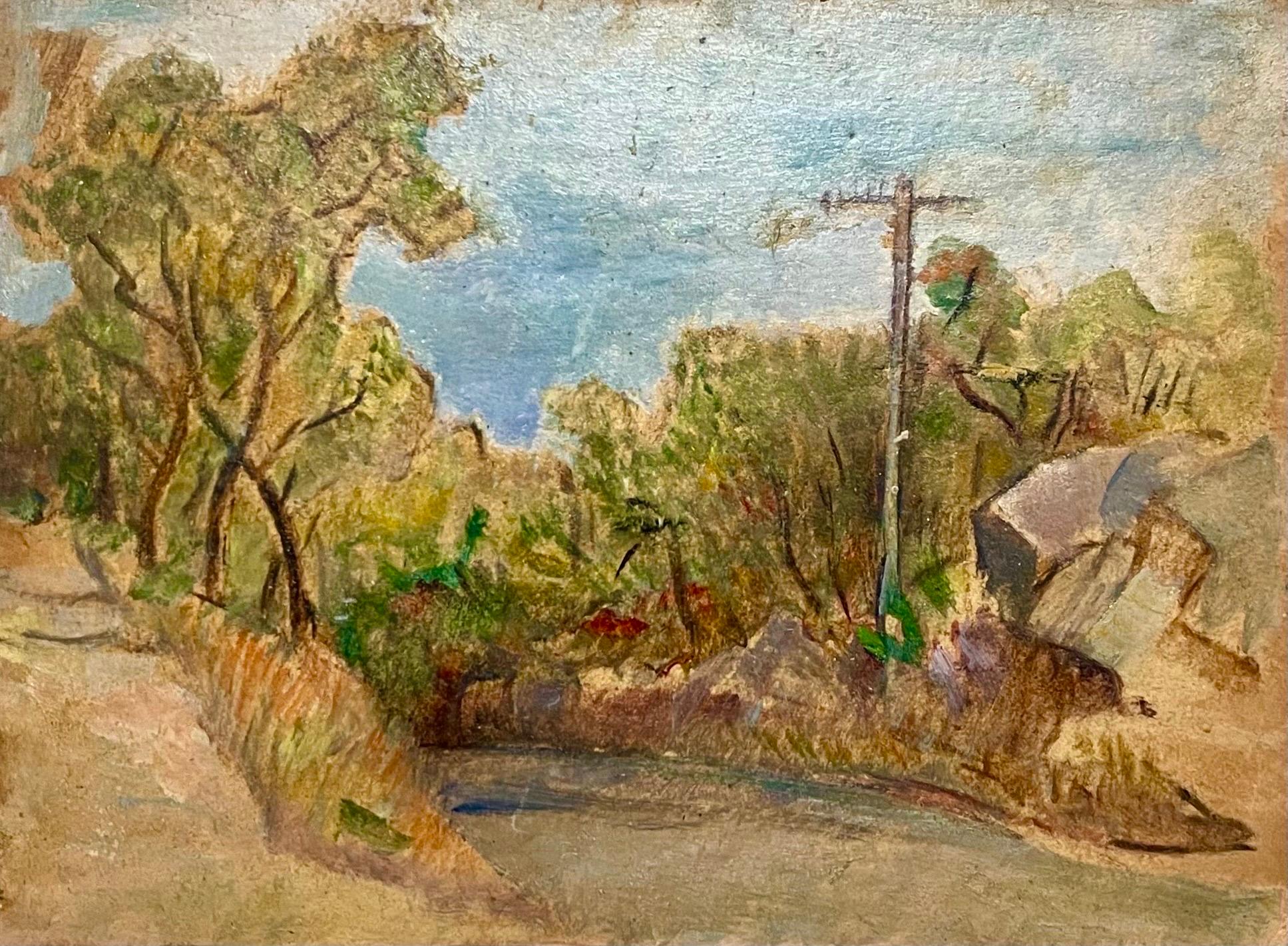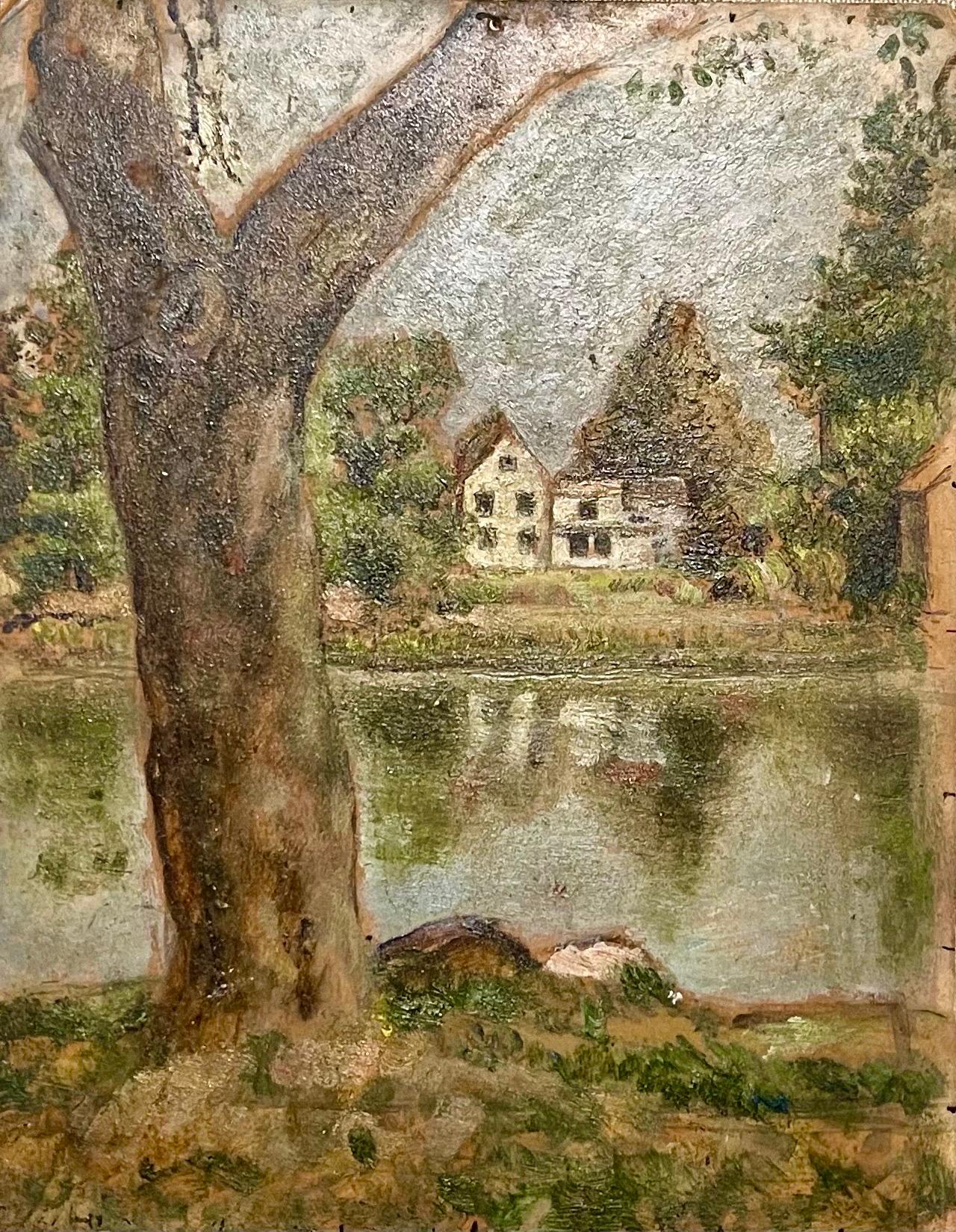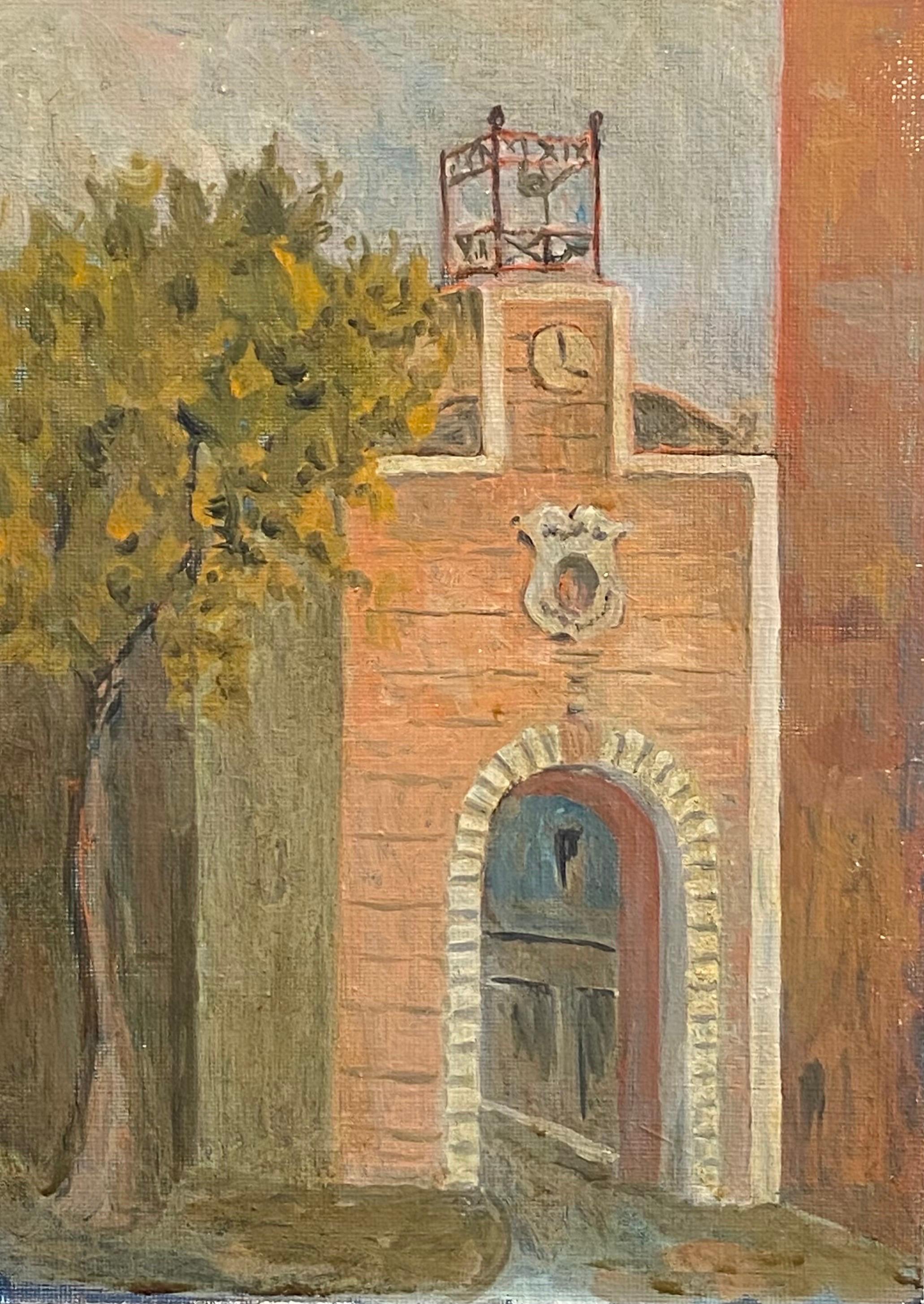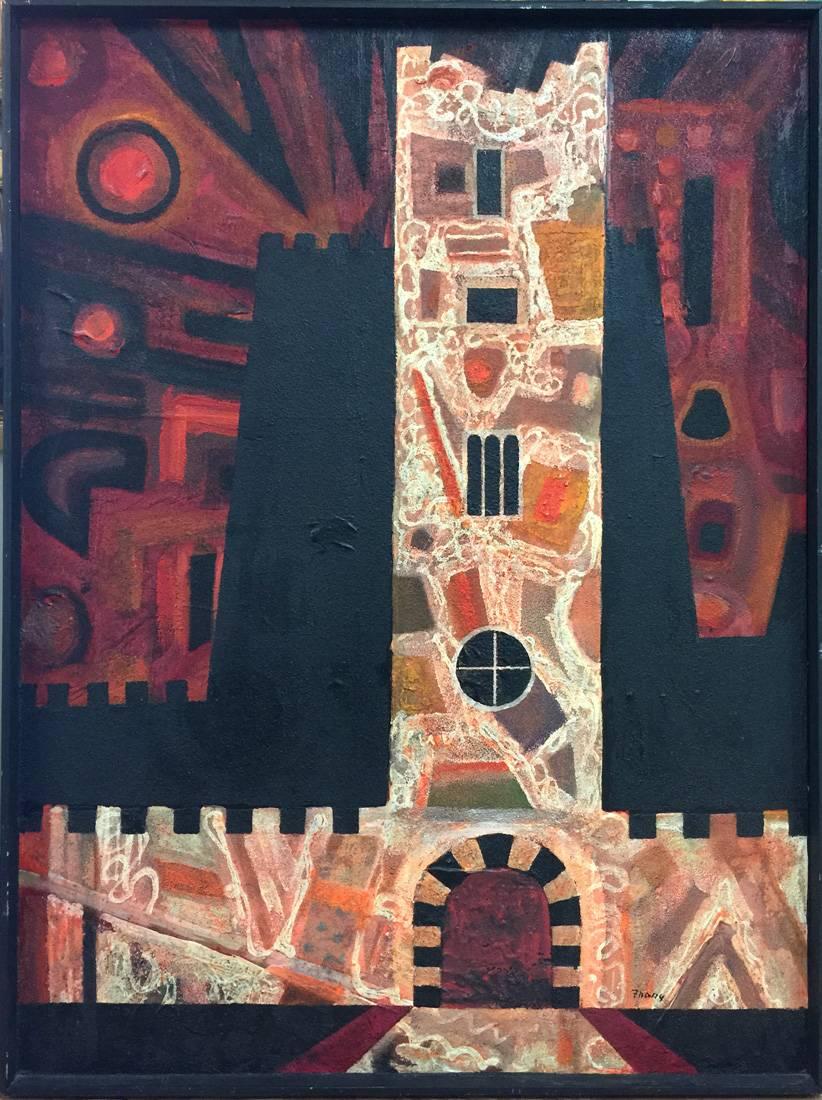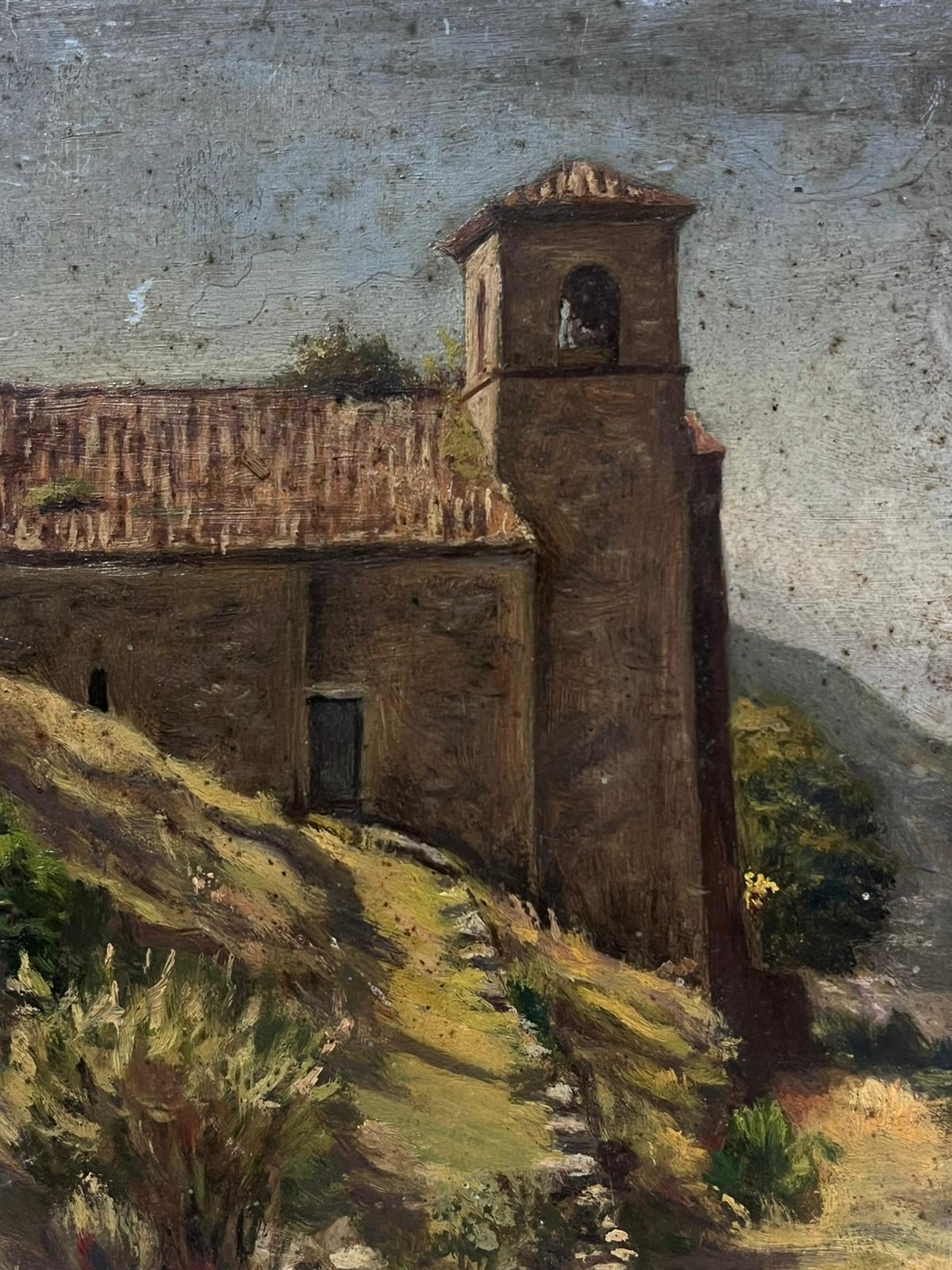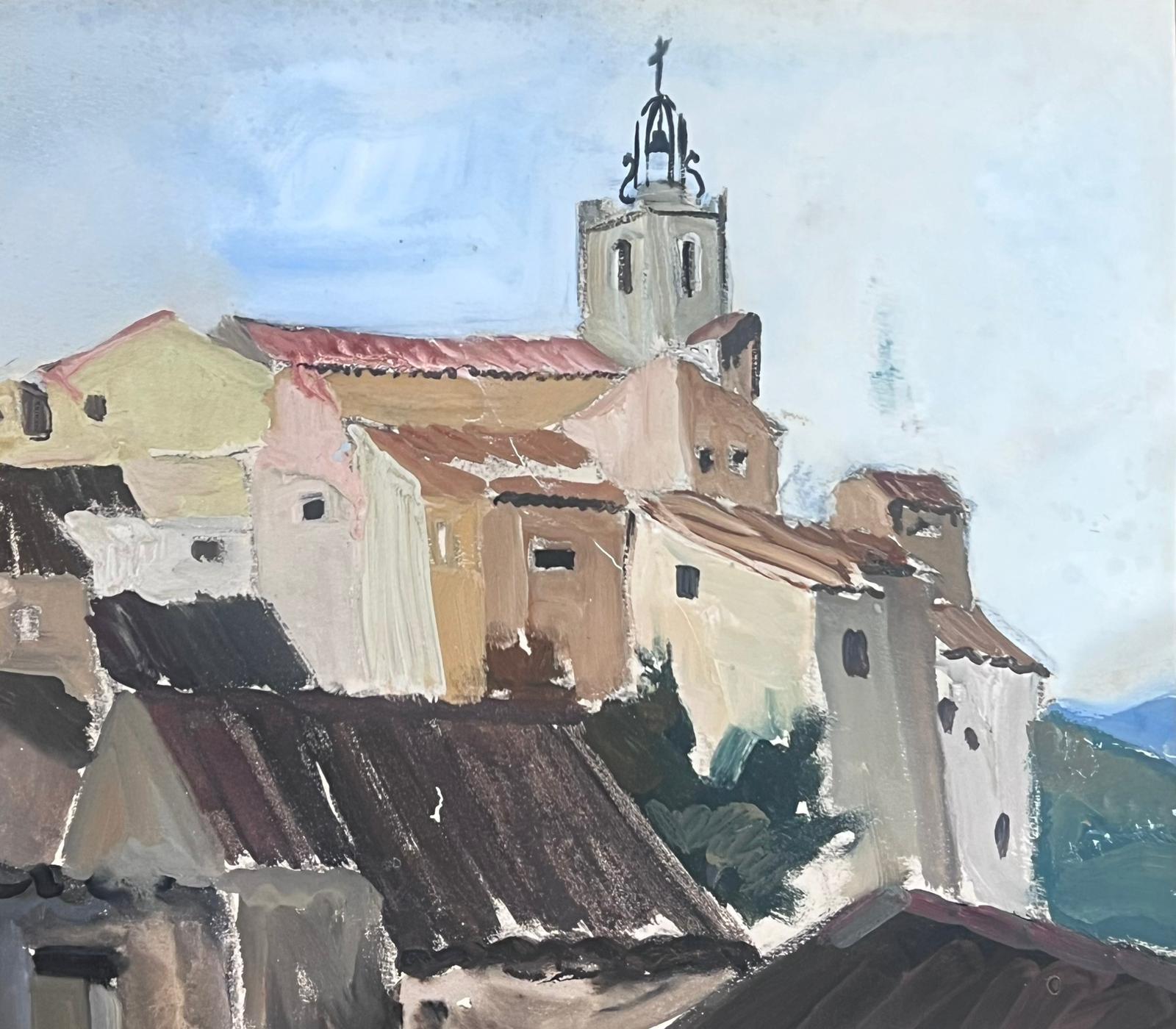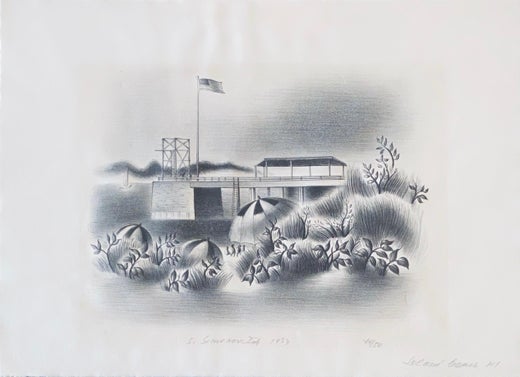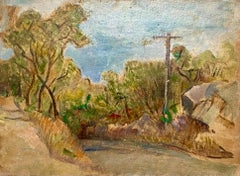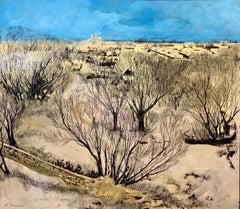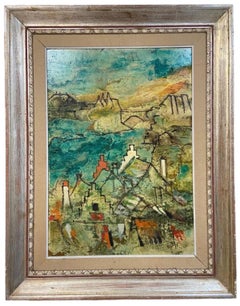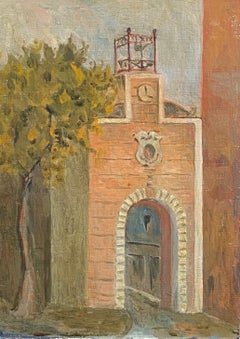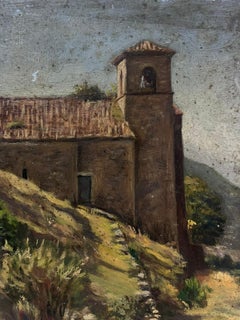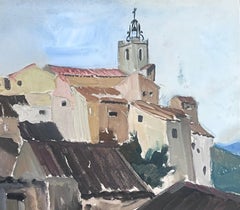Items Similar to Simka Simkhovitch WPA Artist Oil Painting American Modernist Landscape w Tower
Want more images or videos?
Request additional images or videos from the seller
1 of 6
Simka SimkhovitchSimka Simkhovitch WPA Artist Oil Painting American Modernist Landscape w Towerc.1930's
c.1930's
$2,000
£1,496.97
€1,729.77
CA$2,773.33
A$3,106.49
CHF 1,615.03
MX$38,358.90
NOK 20,574.20
SEK 19,449.71
DKK 12,908.47
Shipping
Retrieving quote...The 1stDibs Promise:
Authenticity Guarantee,
Money-Back Guarantee,
24-Hour Cancellation
About the Item
Simka Simkhovitch (Russian/American 1893 - 1949)
This came with a small grouping from the artist's family, some were hand signed some were not.
These were studies for larger paintings.
Simka Simkhovitch (Симха Файбусович Симхович) (aka Simka Faibusovich Simkhovich) (Novozybkov, Russia May 21, 1885 O.S./June 2, 1885 N.S.—Greenwich, Connecticut February 25, 1949) was a Ukrainian-Russian Jewish artist and immigrant to the United States. He painted theater scenery in his early career and then had several showings in galleries in New York City. Winning Works Progress Administration (WPA) commissions in the 1930s, he completed murals for the post offices in Jackson, Mississippi and Beaufort, North Carolina. His works are in the permanent collections of the Dallas Museum of Art, the National Museum of American Art and the Whitney Museum of American Art. Born outside Kyiv (Petrograd Ukraine) into a Jewish family who owned a small department store. During a severe case of measles when he was seven, Simcha Simchovitch sketched the views outside his window and decided to become an artist, over his father's objections. Beginning in 1905, he studied at the Grekov Odessa Art School and upon completion of his studies in 1911 received a recommendation to be admitted to the Imperial Academy of Arts. Though he enrolled to begin classes in architecture, painting, and sculpture at the Imperial Academy, he was dropped from the school roster in December because of the quota on the number of Jewish students and drafted into the army. Simchovitch served as a private in the 175th Infantry Regiment Baturyn [ru] until his demobilization in 1912. Re-enrolling in the Imperial Academy, he audited classes.
Simka Simkhovitch exhibited paintings and sculptures in 1918 as part of an exhibition of Jewish artists and in 1919 placed 1st in the competition "The Great Russian Revolution" with a painting called "Russian Revolution" which was hung in the State Museum of Revolution. In 1922, Simkha Simkhovitch exhibited at the International Book Fair in Florence (Italian: Fiera Internazionale del Libro di Firenze). In 1924, Simkhovitch came to the United States to make illustrations for Soviet textbooks and decided to immigrate instead. Initially he supported himself by doing commercial art and a few portrait commissions. In 1927, he was hired to paint a screen for a scene in the play "The Command to Love" by Fritz Gottwald and Rudolph Lothar which was playing at the Longacre Theatre on Broadway. Art dealers began clamoring for the screen and Simkhovitch began a career as a screen painter for the theater. Catching the attention of the screenwriter, Ernest Pascal, he worked as an illustrator for Pascal, who then introduced him to gallery owner, Marie Sterner. Simkhovitch's works appeared at the Marie Sterner Gallery beginning with a 1927 exhibit and were repeated the following year. Simkhovitch had an exhibit in 1929 at Sterner's on circus paintings. In 1931, he held a showing of works at the Helen Hackett Gallery, in New York City and later that same year he was one of the featured artists of a special exhibit in San Francisco at the California Palace of the Legion of Honor in Lincoln Park. The exhibit was coordinated by Marie Sterner and included four watercolors, including one titled "Nudes". He is of the generation of Russian Soviet artists such as Isaac Pailes, Serge Charchoune, Marc Chagall, Chana Orloff, Isaac Ilyich Levitan, and Ossip Zadkine.
In 1936, Simkhovitch was selected to complete the mural for the WPA Post office project in Jackson, Mississippi. The mural was hung in the post office and courthouse in 1938 depicted a plantation theme. Painted on the wall behind the judge’s bench, “Pursuits of Life in Mississippi”, a depiction of black workers engaged in manual labor amid scenes of white professionals and socialites, was eventually covered over in later years during renovations due to its stereotypical African American imagery. Simka painted what he thought was typical of Jackson. His impression of pre-civil rights Mississippi was evidently Greek Revival column houses, weeping willow trees, working class families, and the oppression of African Americans. He painted African American men picking cotton, while a white man took account of the harvest and a white judge advised a white family, calling it Pursuits of Life in Mississippi.
Though clearly endorsed by the government and initially generally well-received, the mural soon raised concerns with locals as the climate toward racial segregation began to change. The main concern was whether depictions that show African Americans in subjugated societal roles should be featured in a courtroom. The following year, his painting "Holiday" won praise at an exhibition in Lincoln, Nebraska. In 1940, Simkhovitch's second WPA post office project was completed when four murals, "The Cape Lookout Lighthouse and the Orville W. Mail Boat", "The Wreck of the Crissie Wright", "Sand Ponies" and "Canada Geese" were installed in Beaufort, North Carolina. The works were commissioned in 1938 and did not generate the controversy that the Jackson mural had. The main mural is "The Wreck of the Crissie Wright" and depicts a shipwreck which had occurred in Beaufort in 1866. "The Cape Lookout Lighthouse and the Orville W. Mail Boat" depicted the lighthouse built in 1859 and the mail boat that was running mail during the time which Simkhovitch was there. The boat ran mail for the area until 1957. "Sand Ponies" shows the wild horses common to the North Carolina barrier islands and "Canada Geese" showed the importance of hunting and fishing in the area. All four murals were restored in the 1990s by Elisabeth Speight, daughter of two other WPA muralists, Francis Speight and his wife Sarah Jane Blakeslee. There were a number of well known jewish artists included in the WPA FSA New Deal programs including Ben Shahn, William Gropper, Ben Zion, Abraham Rattner and many more.
Simkhovitch's work was selected for a Life Magazine article and in 1940 the artists whose work would appear were highlighted in an exhibit at Morrill Hall on the campus of the University of Nebraska. He also had a one-man show that year in Manhattan. The 4-page Life feature appeared in the December 29, 1941 edition of the magazine and showed Simkhovich's home and studio in Greenwich, Connecticut as well as photographs of his wife, the model Elsa Forne, and two of their three daughters, Sonya and Naomi. Simkovitch continued to paint and do illustrations. In 1946, he sold a painting "Sonya with Fruit" to Upjohn to use in cough medicine advertising, which was included in an exhibit of the Upjohn Collection. The following year, he did his first gallery showing in Connecticut at the Sterling House in Stratford. In February 1949, Simkhovitch and his wife bought a new home in Milford, Connecticut, but Simkhovitch contracted pneumonia during the move. He died after a brief illness on 25 February 1949 in Greenwich, Connecticut.
He has showed his work at Wally Findlay galleries. He was included in the show, Let’s Face It: An Exhibition of Contemporary Portraits 1956 at the Contemporary Arts Museum Houston. Artists featured in the exhibition included: Milton Avery, Max Beckmann, Bernard Buffet, Otto Dix, Raoul Dufy, Lucian Freud, Robert Gwathmey, Frida Kahlo, Leon Kroll, Marino Marini, Georges Rouault, Simkha Simkhovitch, David Alfaro Siqueiros and Andrew Wyeth. Subsequent to his death, Simkhovitch's papers were donated to the Archives of American Art at the Smithsonian Institution in 1989. His works are part of the permanent collections of the Dallas Museum of Art, the National Museum of American Art and the Whitney Museum of American Art, as well as other collections.
- Creator:Simka Simkhovitch (1893 - 1949, Russian, American)
- Creation Year:c.1930's
- Dimensions:Height: 6 in (15.24 cm)Width: 9 in (22.86 cm)
- Medium:
- Movement & Style:
- Period:
- Condition:good. minor wear. please see photos.
- Gallery Location:Surfside, FL
- Reference Number:1stDibs: LU38210484802
Simka Simkhovitch
Simka Simkhovitch was born near the city of Kiev, Russia. When he was 7, he spent a year in bed with a severe case of measles. To amuse himself he used to sketch an old mill outside his window, and thus decided to become an artist. He studied at an art school in Odessa and was recommended to attend the Imperial Academy of St. Petersburg (a singular honor in Russia at the time) before the war and revolution. Swept up into the army before he could attend, his work was hung in the Museum of Revolution in Leningrad. He resumed his studies in 1914 and graduated four years later. He was sent to the United States in 1924 to do illustrations for Soviet textbooks. He quickly applied for and gained U.S. citizenship. Simkhovitch integrated with the art world immediately and galleries such as Midtown Galleries and Marie Sterner took him on as part of their stable of artists. He also was employed by the WPA and executed major mural commissions throughout the country. One of his largest commissions was the Mississippi Court House. Life magazine profiled him twice with full-length features on his life here in this country as an artist. When he died at an early age, the Whitney Museum of Art in New York offered to do a retrospective and the widow denied the possibility and simply put his works away in storage. Considered a master draftsman and an adherent of certain classicism, Simkhovitch’s compositions are often built up in a complicated but well-managed counterpoint. But at heart, he is a romanticist preferring the dreamy colors of a Russian fairy tale.
About the Seller
4.9
Platinum Seller
Premium sellers with a 4.7+ rating and 24-hour response times
Established in 1995
1stDibs seller since 2014
1,777 sales on 1stDibs
Typical response time: 1 hour
- ShippingRetrieving quote...Shipping from: Surfside, FL
- Return Policy
Authenticity Guarantee
In the unlikely event there’s an issue with an item’s authenticity, contact us within 1 year for a full refund. DetailsMoney-Back Guarantee
If your item is not as described, is damaged in transit, or does not arrive, contact us within 7 days for a full refund. Details24-Hour Cancellation
You have a 24-hour grace period in which to reconsider your purchase, with no questions asked.Vetted Professional Sellers
Our world-class sellers must adhere to strict standards for service and quality, maintaining the integrity of our listings.Price-Match Guarantee
If you find that a seller listed the same item for a lower price elsewhere, we’ll match it.Trusted Global Delivery
Our best-in-class carrier network provides specialized shipping options worldwide, including custom delivery.More From This Seller
View AllSimka Simkhovitch WPA Artist Oil Painting Gouache American Modernist Powerline
By Simka Simkhovitch
Located in Surfside, FL
Simka Simkhovitch (Russian/American 1893 - 1949)
This came with a small grouping from the artist's family, some were hand signed some were not.
These were studies for larger paintings.
Simka Simkhovitch (Симха Файбусович Симхович) (aka Simka Faibusovich Simkhovich) (Novozybkov, Russia May 21, 1885 O.S./June 2, 1885 N.S.—Greenwich, Connecticut February 25, 1949) was a Ukrainian-Russian Jewish artist and immigrant to the United States. He painted theater scenery in his early career and then had several showings in galleries in New York City. Winning Works Progress Administration (WPA) commissions in the 1930s, he completed murals for the post offices in Jackson, Mississippi and Beaufort, North Carolina. His works are in the permanent collections of the Dallas Museum of Art, the National Museum of American Art and the Whitney Museum of American Art. Born outside Kyiv (Petrograd Ukraine) into a Jewish family who owned a small department store. During a severe case of measles when he was seven, Simcha Simchovitch sketched the views outside his window and decided to become an artist, over his father's objections. Beginning in 1905, he studied at the Grekov Odessa Art School and upon completion of his studies in 1911 received a recommendation to be admitted to the Imperial Academy of Arts. Though he enrolled to begin classes in architecture, painting, and sculpture at the Imperial Academy, he was dropped from the school roster in December because of the quota on the number of Jewish students and drafted into the army. Simchovitch served as a private in the 175th Infantry Regiment Baturyn [ru] until his demobilization in 1912. Re-enrolling in the Imperial Academy, he audited classes.
Simka Simkhovitch exhibited paintings and sculptures in 1918 as part of an exhibition of Jewish artists and in 1919 placed 1st in the competition "The Great Russian Revolution" with a painting called "Russian Revolution" which was hung in the State Museum of Revolution. In 1922, Simkha Simkhovitch exhibited at the International Book Fair in Florence (Italian: Fiera Internazionale del Libro di Firenze). In 1924, Simkhovitch came to the United States to make illustrations for Soviet textbooks and decided to immigrate instead. Initially he supported himself by doing commercial art and a few portrait commissions. In 1927, he was hired to paint a screen for a scene in the play "The Command to Love" by Fritz Gottwald and Rudolph Lothar which was playing at the Longacre Theatre on Broadway. Art dealers began clamoring for the screen and Simkhovitch began a career as a screen painter for the theater. Catching the attention of the screenwriter, Ernest Pascal, he worked as an illustrator for Pascal, who then introduced him to gallery owner, Marie Sterner. Simkhovitch's works appeared at the Marie Sterner Gallery beginning with a 1927 exhibit and were repeated the following year. Simkhovitch had an exhibit in 1929 at Sterner's on circus paintings. In 1931, he held a showing of works at the Helen Hackett Gallery, in New York City and later that same year he was one of the featured artists of a special exhibit in San Francisco at the California Palace of the Legion of Honor in Lincoln Park. The exhibit was coordinated by Marie Sterner and included four watercolors, including one titled "Nudes". He is of the generation of Russian Soviet artists such as Isaac Pailes, Serge Charchoune, Marc Chagall, Chana Orloff, Isaac Ilyich Levitan, and Ossip Zadkine.
In 1936, Simkhovitch was selected to complete the mural for the WPA Post office project in Jackson, Mississippi. The mural was hung in the post office and courthouse in 1938 depicted a plantation theme. Painted on the wall behind the judge’s bench, “Pursuits of Life in Mississippi”, a depiction of black workers engaged in manual labor amid scenes of white professionals and socialites, was eventually covered over in later years during renovations due to its stereotypical African American imagery. Simka painted what he thought was typical of Jackson. His impression of pre-civil rights Mississippi was evidently Greek Revival column houses, weeping willow trees, working class families, and the oppression of African Americans. He painted African American men picking cotton, while a white man took account of the harvest and a white judge advised a white family, calling it Pursuits of Life in Mississippi.
Though clearly endorsed by the government and initially generally well-received, the mural soon raised concerns with locals as the climate toward racial segregation began to change. The main concern was whether depictions that show African Americans in subjugated societal roles should be featured in a courtroom. The following year, his painting "Holiday" won praise at an exhibition in Lincoln, Nebraska. In 1940, Simkhovitch's second WPA post office project was completed when four murals, "The Cape Lookout Lighthouse and the Orville W. Mail Boat", "The Wreck of the Crissie Wright", "Sand Ponies" and "Canada Geese" were installed in Beaufort, North Carolina. The works were commissioned in 1938 and did not generate the controversy that the Jackson mural had. The main mural is "The Wreck of the Crissie Wright" and depicts a shipwreck which had occurred in Beaufort in 1866. "The Cape Lookout Lighthouse and the Orville W. Mail Boat" depicted the lighthouse built in 1859 and the mail boat that was running mail during the time which Simkhovitch was there. The boat ran mail for the area until 1957. "Sand Ponies" shows the wild horses common to the North Carolina barrier islands and "Canada Geese" showed the importance of hunting and fishing in the area. All four murals were restored in the 1990s by Elisabeth Speight, daughter of two other WPA muralists, Francis Speight...
Category
1930s American Modern Landscape Paintings
Materials
Oil, Board, Gouache
Simka Simkhovitch WPA Artist Oil Painting American Modernist Landscape Pond Tree
By Simka Simkhovitch
Located in Surfside, FL
Simka Simkhovitch (Russian/American 1893 - 1949)
This came with a small grouping from the artist's family, some were hand signed some were not.
Thes...
Category
1930s American Modern Landscape Paintings
Materials
Oil, Board
Jerusalem Modernist Landscape Oil Painting Israeli Bezalel Artist, Judaica Art
By Ivan Schwebel
Located in Surfside, FL
Ivan Schwebel, Israeli American (1932-2011) Oil on canvas.
Painting of Winter Landscape. Signed Schwebel, 1985. Sight- L-27" x W-31.5", Frame- L-28.5" x W-32".
Ivan Schwebel, Painter. Was born 1932, U.S.A. and immigrated to Israel 1963 after living in Spain, France and Greece.
Studies: 1953-55 with Kimura Kyoen whilst serving with the U.S.Army in Japan; 1955-61 Institute of Fine Arts, with Philip Guston; New York University.
Larry Abramson, who is very much in the mainstream of Israeli art, curated an exhibition of Schwebel’s work at the Jerusalem Print Workshop in the early 1980s; in the accompanying text, he described him as “an artist from the New York School ship-wrecked on a hill near Jerusalem.”
IN SCHWEBEL’S BEST WORK, THE paint speaks for itself: the pools and explosions of rich color, achieved with pigment that he would grind and mix himself, the luminous figures emerging out of dark shadows, the quirky, dramatic compositions.
Schwebel was erudite, with a passion for the bible and Jewish and Israeli history. He delved into all of it for his subject matter, bringing together characters and narratives regardless of time, and setting them in modern- day Tel Aviv or Jerusalem, the Judean hills, or New York City. He liked to play with ideas, and thoroughly mixed his visual metaphors. He showed David and Bat-Sheva next to a Nazi deportation train, and Job despairing over his relationship with the Palestinians. He based his characters on photographs of himself, friends and family, or movie stars.
On his website, he describes a series of paintings about anti-Semitism in which the Holocaust is merged with the Spanish Inquisition: “Abarbanel who tried to negotiate with Ferdinand and Isabella is reincarnated in Rumkowski – the German appointed Head of the Lodz Ghetto. The bridge connecting two parts of the Ghetto is spanned over a present-day Tel Aviv cityscape.
He was included in a portfolio that included Ivan Schwebel, Michael Gross, Liliane Klapisch and Moshe Kupferman, five of Israel's leading contemporary artists who were each approached in May 1977 with a request to contribute a hand-printed screenprint for a portfolio to be titled "Jerusalem". The sole term of reference was the name "Jerusalem", with no qualifications at all. The five artists then spent time working completely independently and individually on the project at the Jerusalem Print Workshop. Each screenprint was hand-signed by their respective artist and numbered from the edition of 200, hand-printed on BFK Rives paper Published by Whartman and Sacks Art Publications
His “Tel Aviv” series, in contrast, is fun: “Chen Cinema” shows a couple of actors who seem to have stepped out of an old romantic movie to cuddle in the shabby street outside the cinema. In his final “Safe Place” series of paintings, he goes beyond self-conscious narrative to create his own Garden of Eden.
Select Group Exhibitions:
Landscape and Nature: Contemporary Israeli Prints...
Category
1970s Modern Landscape Paintings
Materials
Canvas, Oil
Italian Modernist Surrealist Architecture Landscape Oil Painting Lazzaro Donati
By Lazzaro Donati
Located in Surfside, FL
Lazzaro Donati (Italian, 1926-1977)
Oil on board. Colorful Architectural Italian Landscape. Porto Azzurro, 1964
Hand signed upper right. signed, titled on back of panel.
Dimensions: (Frame) H 37" x W 29", (Panel) H 27" x W 19"
Lazzaro Donati was born in Florence and attended the Academy of Fine Arts. He began to paint in 1953, and in 1955 held his first exhibition at the Indiano Gallery in Florence. Within three years eleven exhibitions followed in Italy, and as his reputation grew he was invited to give major exhibitions in London, Paris, New York, Chicago, Rio de Janeiro and Montevideo. He is considered one of the foremost contemporary Italian painters and his paintings hang in museums and private collections throughout the Americas, Europe and Asia. His work is recalling the works of the french Raoul Dufy, Dunoyer de Segonzac, Francois Gall and Jean Jansem. This particular work is reminiscent of the work of Manolo Valdes. Donati lived and worked at 24 Piazza Donatello in Florence, the square where generations of artists have created works worthy of the great Florentine tradition. As you entered the narrow hallway to his studio, a gilded life-size Venetian angel beckoned you to his door. Once inside, the present faded away and you found yourself in an atelier where early masters might have worked during the Renaissance. Within, luxurious Persian rugs set off the innumerable objects d’art and antique furnishings...
Category
1960s Surrealist Figurative Paintings
Materials
Oil, Panel
Untitled, Lonely Abstract Landscape Italian Expressionist Oil Painting
By Ivan Kurach
Located in Surfside, FL
Genre: Expressionist
Subject: Landscape
Medium: oil
Surface: board
Country: Italy
unsigned
Ivan Kurach (1909 – 1968) Ukranian-Italian lived and studied in Italy. Born in the Ukraine...
Category
Mid-20th Century Modern Figurative Drawings and Watercolors
Materials
Oil, Board
WPA Period "Coastal Village" American Modernist Realism Oil Painting Lev Landau
By Samuel David Lev-Landau
Located in Surfside, FL
Signed and titled with Yiddish inscription verso.
9 X 12 inches board size. beng sold unframed.
Painter, New York, N.Y. Samuel David Lev-Landau was born in Warsaw, Poland and emigr...
Category
Mid-20th Century Modern Landscape Paintings
Materials
Oil
You May Also Like
1950's French Modernist/ Cubist Painting signed - French Clock Tower
By Bernard Labbe
Located in Cirencester, Gloucestershire
Artist/ School: Benard Labbe
Title: The Old Church
Medium: oil painting on board, unframed
Size:
board: 8.75 x 7.25 inches
Provenance: private collec...
Category
Mid-20th Century Modern Landscape Paintings
Materials
Oil
"Victoria Tower England" Mid Century Modern Texas Painting Oil
By Michael Frary
Located in San Antonio, TX
Michael Frary (1918 - 2005) Austin Artist Image Size: 40 x 30 Frame Size: 41 x 31 Medium: Heavy Textured Acrylic 1966 "Victoria Tower"
Biography
Michael Frary (1918 - 2005)
M...
Category
1960s Modern Landscape Paintings
Materials
Oil
1930's French Impressionist Painting Bell Tower On Hill Top Landscape
Located in Cirencester, Gloucestershire
French Countryside Landscape
by Edmond Quinton (French 1892-1969) *see notes below
oil painting on board/ panel, unframed
size: 9.5 x 7.5 inches
condition: overall good and sound, so...
Category
Early 20th Century Impressionist Landscape Paintings
Materials
Oil
1930's French Impressionist Gouache Church Tower Town Landscape
Located in Cirencester, Gloucestershire
French Landscape
by Louise Alix, French 1950's Impressionist
gouache on artist paper
painting: 12 x 13 inches
provenance: from a large private collection of this artists work in Nor...
Category
Mid-20th Century Impressionist Landscape Paintings
Materials
Gouache
$486 Sale Price
30% Off
Vintage Signed American Modernist Framed Landscape Architectural Oil Painting
Located in Buffalo, NY
Antique American modernist signed landscape oil painting. Oil on canvas. Signed. Framed.
Category
1960s Modern Landscape Paintings
Materials
Canvas, Oil
$556 Sale Price
20% Off
The little house by I. Ch. Goetz - Oil on canvas 37x45 cm
Located in Geneva, CH
Work on canvas
Category
Mid-20th Century Modern Landscape Paintings
Materials
Oil
$352 Sale Price
20% Off
More Ways To Browse
American Work Bench
Magazine Covers 1930s
David Wright
Socialite Painting
1930s Circus Art
Vintage Running Board
Black Painted Buffet
Weeping Willow Art
Geese Painting
Socialite Portrait Painting
Robert Avery
Connecticut Dealers
Andrew Wyeth Studys
Draft Horses
Greek Horse Sculpture
Andrew Jackson
Large Hunting Landscape Oil Paintings
Marino Marini Horse
